September 1, 2017
Air Date: September 1, 2017
FULL SHOW
SEGMENTS

Houston: Drenched, Damaged and Determined
View the page for this story
Hurricane Harvey broke records for rainfall, inundating thousands of homes and businesses and leaving tens of thousands homeless in the Houston area of Texas before it moved east through Beaumont and Port Arthur into Louisiana. Still, cleanup in Houston began as soon as the sun came out, and sodden sheetrock and carpet is piling up on curbsides. To discuss how the storm played out and how the country’s fourth-largest city can prepare for more such extreme weather events, host Steve Curwood spoke with Houston Public Media's Laurie Johnson. She notes Houston residents are resilient in the face of the public safety risks and chores of rebuilding ahead. (10:44)
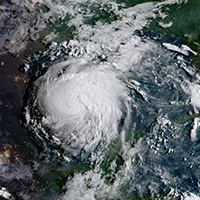
Global Warming & Harvey
View the page for this story
A warmer world is a rainier world, as warmer air holds more moisture. The exceptional warmth of Gulf of Mexico waters in 2017 helped fuel Hurricane Harvey’s deluge, Kevin Trenberth, senior scientist at the National Center for Atmospheric Research, tells host Steve Curwood. They discuss how new satellite and imaging technology helped accurately forecast Harvey’s ferocity. But proposed cuts to federal funding for key technology could hinder future efforts to prepare for extreme weather. (08:41)
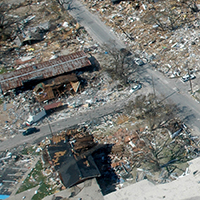
Justice After Storm Harvey
View the page for this story
Though Hurricane Harvey’s record rainfall flooded the rich and poor alike, recovery is much harder for the disadvantaged, as Texas Southern University Professor and environmental justice scholar, Robert Bullard, and host Steve Curwood discuss. (06:36)

Beyond the Headlines
/ Peter DykstraView the page for this story
Peter Dykstra returns to discuss what’s going on Beyond the Headlines with host Steve Curwood. They note how Hurricane Harvey raises questions on flood insurance and climate politics, and discuss Kenya’s new plastic bag ban. For environmental history, Peter reminds us of a time when Republican presidential nominee George H.W. Bush championed a clean environment. (03:49)

Science Note: The Leaning Tree of New Caledonia
/ Lizz MalloyView the page for this story
California scientists assumed that New Caledonia’s Cook Pine Tree, famous for its off-kilter tilt, routinely points south. But the research team’s global survey revealed that the tree actually always reaches for the Equator. As Lizz Malloy explains in this week’s note on emerging science, nobody quite knows the reason for this singular trend. (01:31)
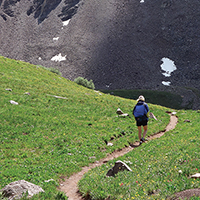
Walks of a Lifetime: Extraordinary Hikes From Around the World
View the page for this story
Bob and Martha Manning have walked thousands of miles together, through wilderness and dense cities, on hiking trails and along sacred pilgrimage paths. Their 2017 book Walks of a Lifetime brings together thirty favorites from around the world, with walks for beginners as well as experienced hikers. In this conversation with host Steve Curwood they explain their tips for fellow trekkers and the benefits and surprises of seeing the world on two feet. (13:11)
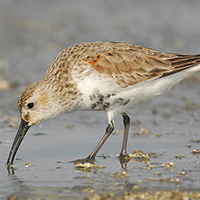
BirdNote: Pungent Mudflat
/ Michael SteinView the page for this story
Michael Stein samples the sounds and smells of the mudflat in this week’s BirdNote®, encountering sandpipers, dunlins, clams, worms and a variety of powerful odors. (02:06)
Show Credits and Funders
Show Transcript
HOST: Steve Curwood
GUESTS: Laurie Johnson, Kevin Trenberth, Robert Bullard, Bob and Martha Manning,
REPORTERS: Peter Dykstra, Lizz Malloy, Michael Stein
[THEME]
CURWOOD: From Public Radio International, this is Living on Earth. I'm Steve Curwood. As Houston dries out in the wake of Tropical Storm Harvey, the extent of the catastrophic flooding points to a long period of restoration.
[THEME]
JOHNSON: As many as 100,000 people could end up homeless. This is not going to be a fast turnaround. This will not be a fast recovery. The rest of the country will move on and here in Houston we’ll be dealing with this for months, if not years, to come.
CURWOOD: More intense storms with massive quantities of rain and flooding like Harvey are coming, and global warming is a player.
TRENBERTH: All of these events these days have a component relating to climate change. You know, it may be a relatively small fraction -- 10, 15 percent. But that extra 10 percent can push you across various thresholds, and once you cross these thresholds, things break.
CURWOOD: Those stories and more, this week on Living on Earth. Stick around.
[NEWSBREAK MUSIC: Boards Of Canada “Zoetrope” from “In A Beautiful Place Out In The Country” (Warp Records 2000)]
[THEME]
Houston: Drenched, Damaged and Determined

Major storms in the Houston Metro area raise concerns about oil spills and chemical releases from the storage tanks that line the Houston ship channel, as well as numerous other petrochemical facilities throughout the region. (Photo: Petty Officer 1st Class Patrick Kelley/Released / U.S. Coast Guard, Flickr CC BY-NC-ND 2.0)
CURWOOD: From PRI, and the Jennifer and Ted Stanley Studios at the University of Massachusetts Boston, this is Living on Earth. I’m Steve Curwood.
Hurricane Harvey merits extravagant language. The cyclone that first came ashore in South Texas as a Category 4 hurricane on August 25th set a rainfall record on the US continent when Harvey stalled for days over Houston, America’s fourth largest city. It dumped some 55 inches of rain that put 85 percent of the city under water, closed most businesses and schools and forced tens of thousands of people from their homes. Fortunately the death toll has been low in comparison to the destruction, thanks in large part to the remarkable generosity and help coming from the people of the Houston area themselves and thousands of emergency workers and volunteers.
Laurie Johnson, Executive Producer and Newscaster with Houston Public Media has been reporting on the city since the storm hit and joins us from her home in the northern suburbs. Welcome to the program.
JOHNSON: Thank you, Steve. Glad to be here.
CURWOOD: Yeah, I guess at this point, thouth, maybe the show should be Living on the Water for you, huh?
JOHNSON: [LAUGHS] Oh my goodness, it's been unreal to see the images of so much of Houston underwater.
CURWOOD: So, the sun is out now, but I mean, where are people now in terms of processing the damages, both emotional and physical from this storm?
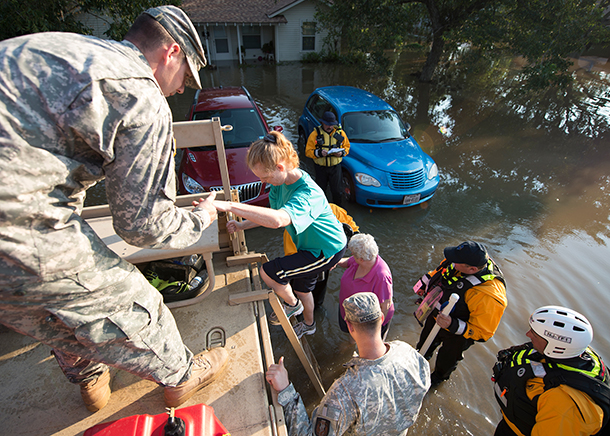
State National Guard members from across the country came to the Gulf Coast to assist in the evacuation process after Hurricane Harvey hit (Photo: Senior Master Sgt. Robert Shelley / Air National Guard, Flickr CC BY 2.0)
JOHNSON: Some homes are still inaccessible, and so people are still in shelters. An estimate I heard is that as many as 100,000 people could end up homeless after this because their homes will be uninhabitable. So, as you can imagine, this is not going to be a fast turnaround. This will not be a fast recovery. The rest of the country will move on, and here in Houston we'll be dealing with this for months, if not years, to come.
CURWOOD: What insight do you have from what happened in New Orleans with Katrina with such massive flooding? Now, I'm not in Houston. You are. Looks to me that you folks are in better shape than the early aftermath of Katrina.
JOHNSON: One of the things that has set this apart was the number of locals, who, despite the fact that perhaps their own homes were flooding, got out, got boats, found ways to their neighbors, and helped each other. And what we saw with Katrina was that it was the most vulnerable. They did not have the kind of resources to be able to do that, and they were left stranded. And here in Houston, this hit everyone. This was not just poor neighborhoods, and in order to survive it, people had to help each other
.
Houston, the metro area, 650 square miles of metro area, and there's an estimate that 350 square miles are under water. That's impossible for just local police and firefighters to get to. It had to be a community effort, and that's exactly what it's been.
CURWOOD: And, of course, here we are several days on, and it's still not over. How long do folks there say it’ll take for the water to be gone, for people really to be able to get back and see what's happening?
JOHNSON: It depends on what part of the city you're in, and what watershed or reservoir you're close to. If you're on the far west side in the Katy area and in west Houston, the Addicks and Barker reservoirs. These are the reservoirs where they were worried about the dam failures, so they had to be releasing water into the neighborhoods, and they expect homes in that area to remain flooded for weeks. So, if you're unfortunate enough to be in that area, it may be weeks before you can even get to your home to see the extent of the damage.
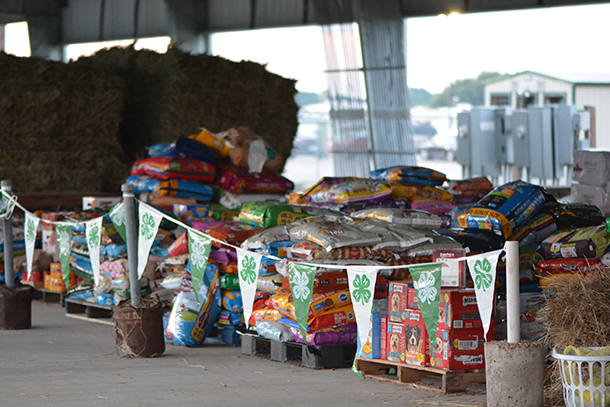
Donations of animal food arrived at the animal shelter and supply point in Angleton, Texas after the storm. At least 1,000 animals were being cared for there as of Aug. 30, 2017. (Photo: Kathleen Phillips / Texas A&M AgriLife Extension Service, Flickr CC BY-NC-ND 2.0)
In other parts of town, it’ll drain much more quickly and people, in fact, are already cleaning up in many areas of town and ripping out carpets and sheetrock, and we're already seeing piles of garbage and debris on the curbsides waiting for pick up.
CURWOOD: And, by the way, how is your radio station KUHF? How are you guys doing? How much flooding did you experience?
JOHNSON: Well, thankfully we did not get any water in our building, but the entire building was surrounded by high water. So, for days we had a team a ride-out team in the building and they were on their own, and they had to do everything. The rest of us who were out in the community couldn't get to them, couldn't navigate the roads, and now that the freeways are clear, we can now get in and relieve them and let them get some rest and take over. But, yes, the station is based at the University of Houston, and much of the campus was underwater.
CURWOOD: I know it's early in in this recovery phase, but what's being said about what could be done to make things different in the future because it's, now, not a matter of if you'll have this again, it's when you have this again.
JOHNSON: You know, first thing I want to say is that no city in this country could have gone through 55 inches of rain in a few days without massive flooding. A lot of people have been pointing to Houston and saying, “Oh this is because of rampant unchecked development” or, “They should have known, they had Hurricane Ike, they had Tropical Storm Allison”. Well, there's nothing you could do with that much rainfall in that short a time, but there are things that we can do to improve, and there are things we can do to perhaps change our building codes in the future.
There are things that will have to be done for the infrastructure, for instance, the dams. The Army Corps of Engineers has labeled two of our dams in this region among the most unsafe in the country, but I am confident that Houston will, will make changes. I do believe that Houston is a city that learns from its mistakes, and is very innovative, and so I think that we will move forward and make changes.
CURWOOD: What efforts do you think that the city, the county, the region will make to help those people get back on their feet again? They're not just poor people. As you say, this hit all income ranges, so people who are probably pretty affluent and running their businesses or their shops or adding value economically to the region. If they're wiped out, they're not going to be able to move forward.
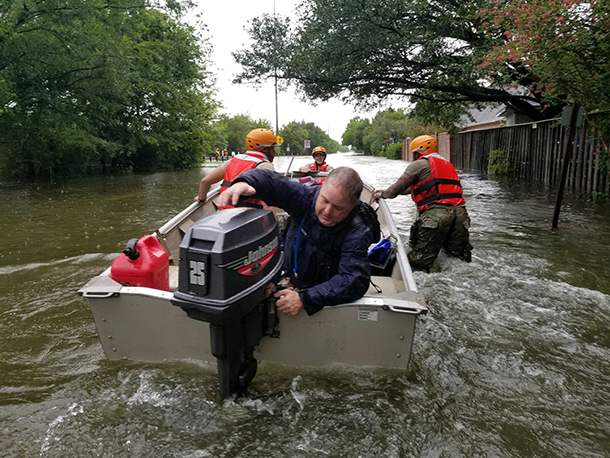
Laurie Johnson of KUHF estimates that 100,000 Houstonians could be homeless in the aftermath of Harvey. (Photo: Lt. Zachary West, 100th MPAD, Flickr CC BY 2.0)
JOHNSON: I think there are some things that we learned in the aftermath of Hurricane Katrina when we absorbed 200,000 people from New Orleans and Louisiana, and we got those people into temporary housing. We got those people into the local schools, and many, many, many of them stayed because they found that Houston was prosperous and welcoming. I think we will have learned some things from that.
One thing that they did during Katrina was, instead of waiting for FEMA assistance to get everybody into temporary housing, the city of Houston issued vouchers and put people into vacant apartments, and it was cheaper than what the federal assistance would have cost. So, things like that. There will be strategies that I think we'll be looking into on how to recover quickly and get the city back up and running.
CURWOOD: And maybe New Orleans will help.
JOHNSON: You know, we've heard so many stories of people coming here from Louisiana just to help with the rescue, and so many of them said to us, you know, they were here because of what we had done for them during Katrina, and they came with boats. They called it the “Cajun Navy,” and they arrived here and rescued people for days. But it is going to take a long time, and there's going to be businesses that go out of business. They will not be able to come back, and there will be people that will move away.
CURWOOD: Now, Mayor Sylvester Turner chose not to call for a mandatory evacuation, when it was clear that there was going to be a lot of rain. Tell me why he made that decision and who has reacted favorably or critically to that call.
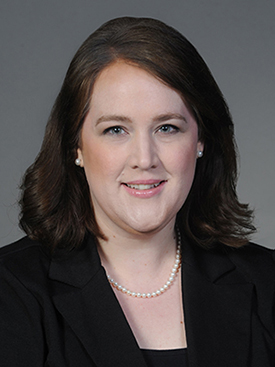
Laurie Johnson is an Executive Producer and Newscaster with KUHF – Houston Public Media. (Photo: Houston Public Media)
JOHNSON: You know, there's been a lot of criticism of that, but we have seen here in Houston what has happened in the past when widespread evacuations have been called. What ends up happening is, when they call these evacuations for large areas, everybody evacuates, whether they're in the evacuation zone or not. Everyone sort of panics. And we use Houston as sort of a catch all, but really what we're talking about is almost a 13 county region with about eight million people. If you get even just half of those four million people trying to evacuate at one time, you are looking at complete and utter gridlock on the roads, and that's what we saw when Hurricane Rita was heading toward Houston. This was just a few weeks after Katrina hit, and Rita was coming toward us and people were panicking and deciding to get out of town, and they were stuck on the freeways for 24 hours. A hundred people died because of heat stroke and dehydration because they couldn't get water. They couldn't get gasoline. They were stranded.
We would have the same thing. We would have millions of people on the roads but instead of dying of heat stroke. They would have drowned because our freeways were completely flooded, so I think that the mayor absolutely made the right decision. He knew that we would have, instead of a mass evacuation, we would have mass casualties if people tried to get out.
CURWOOD: So what is the risk from chemical spills at this point? What's being said, what's being reported?
JOHNSON: There has not been a whole lot on this particular issue in this scenario with Harvey. You know, Hurricane Harvey hit much further south of us in the Corpus Christi-Rockport area, bringing high winds and structural damage. That's not what we got here in Houston. This was rising water, and so there hasn't been as much concern about the integrity of the petrochemical industry here.
There has been some talk about the possibility of some underground, or should I say “underwater,” pipelines being compromised, specifically with the San Jacinto River, which runs through northeast Houston and has pipelines running underneath its bed. So there's been concern there, but other than that there hasn't been a whole lot of concern about what might happen with the refineries because they are equipped for this kind of thing. The big concern is, when we have a Hurricane Ike type situation with intensive winds and structural damage.
CURWOOD: Well, Laurie Johnson, thanks so much for taking the time. Despite all that's going on, you still sound, well, optimistic looking forward.
JOHNSON: That is the heart of Houston. We are an optimistic city, and we believe deep down that we can do whatever is asked of us. So, absolutely I'm optimistic and I know we will get through this, and we really appreciate you and everyone across the country, all the thoughts and prayers and help that has been sent our way.
CURWOOD: Laurie Johnson is a Newscaster and Executive Producer with Houston Public Media, that's KUHF 88.7. Thanks so much for taking the time with me today.
JOHNSON: Thank you, Steve.
Related links:
- Storm coverage from Houston Public Media
- New York Times: Where to donate to Harvey Victims
[MUSIC: Karla Bonof, “The Water Is Wide” on Restless Nights, Traditional Scottish, Columbia Records]
CURWOOD: Coming back from catastrophe, and looking to the future for Houston. Keep listening to Living on Earth.
ANNOUNCER: Support for Living on Earth comes from the Gordon and Betty Moore Foundation, and from a friend of Sailors for the Sea, working with boaters to restore ocean health.
[CUTAWAY MUSIC: Ted Yoder, “The Water Is Wide” on Chocolate Skies, traditional Scottish melody, CD Baby]
Global Warming & Harvey
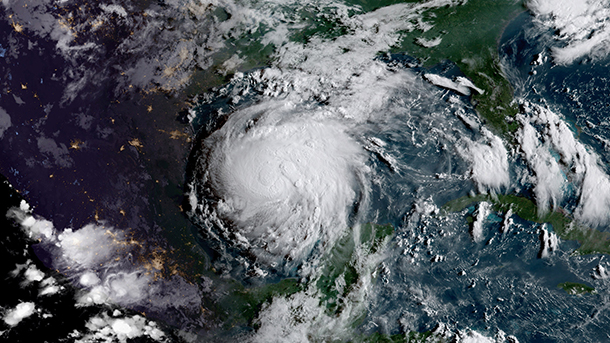
Harvey as viewed from space on August 24th, just before strengthening into a hurricane. (Photo: NOAA/NASA GOES Project, Flickr CC BY 2.0)
CURWOOD: It’s Living on Earth, I’m Steve Curwood.
Hurricane Harvey has been called “unprecedented”, which is prompting questions about the role of global warming in its record-breaking rainfall. So we called up Kevin Trenberth, a distinguished Senior Scientist at the National Center for Atmospheric Research in Boulder, Colorado, to find out what he thinks.
Kevin, welcome back to Living on Earth.
TRENBERTH: It's nice to join you again although these circumstances might be better, I suppose, in Texas.
CURWOOD: What is so unprecedented about this storm system?
TRENBERTH: Well certainly it's broken many records, evidently, in terms of the total rainfall, both the extent and the amount at individual locations. Many places topping over 40 inches. The storm itself has broken records. It developed to a category four storm, even though it was in a location that wasn't ideal for a strong development. It was quite close to land when it did that, and then, when it moved over the land, it stayed active for something like 70 hours before it went back over the ocean; whereas, these storms usually die out once they go over land and the average lifetime of these storms over land is about 27 hours or something like that. And so, it was able to sustain itself because it was so large and all of the moisture that was flowing in from the Gulf kept refueling the storm, so to speak, and of course, at the same time, absolutely drenching Houston.
Time-lapse of Hurricane Harvey’s destructive path through Texas. (Produced by KXAN)
CURWOOD: So, why? Why was it able to go back out to sea and get more energy and keep going?
TRENBERTH: So, the gulf has been very warm. This is, of course, the time of year - peak summer - when the sea surface temperatures are at their highest. They're normally getting up to about 85, 86 degrees, and this year there are over a very extensive area, 87 degrees Fahrenheit. So, there's very warm water out there, anyway.
It's warmer than normal for two reasons: one, there is a natural variability component which may actually relate to things like the El Nino last year and the year before in the Pacific that suppressed activity in the Atlantic, and then there's also the climate change aspect. So, the sea temperatures are higher because of climate change, and so there is tremendous amounts of warm moist air over the Gulf. The rule of thumb is, for one degree Fahrenheit there is five percent more moisture in the atmosphere. And so a couple of degrees above normal means there is 10 percent more moisture in the atmosphere, and this is adding then to the fuel that's available for the storm. And, of course, it adds to the rainfall as well.
CURWOOD: In other words, what goes up in the form of moisture must come down.

The Texas National Guard rescues residents flooded out by Hurricane Harvey. (Photo: Staff Sgt. Tim Pruitt / National Guard, Flickr CC BY 2.0)
TRENBERTH: Yes, and so, when the moisture rains out, it gives back the heat that went into evaporating in the first place. That's the fuel for the hurricane itself, and so it's been able to refuel itself especially through the spiral arm bands that are surrounding the storm, and one of these spiral arm bands was sort of stuck right over Houston, and the moisture was just continuing to flow over land, long after the storm made landfall. And so this is what helped to sustain the storm, but it related very much to the fact that it was it was quite a large storm also.
CURWOOD: So, what's going on around the world? We saw those huge floods in California, but there's things going on in Asia right now. Talk to me about that.
TRENBERTH: Yes, and so the monsoon has been very active and there's been a tremendous amount of flooding in the mountains in Nepal, in India, in Bangladesh, from mid-July up until the present, and there have been something like 1,000 deaths over and that region. We don't see much of it in the news on a day to day basis here because we're so preoccupied with stuff that's going on in our own country, but it's not an unrelated phenomenon.
CURWOOD: Talk to me about the hurricane modeling and how it might have changed since Katrina which is now 12 years ago. What tools are meteorologists able to use today, in terms of getting a bead on a storm system that could really blow up in what we've seen in South Texas?
TRENBERTH: So, in the first place, of course, there is new technology in space and there's some new satellites that have just gone up and NOAA has been using this so-called GOES satellites. These are the geo-stationary satellites, but they have a much more rapid cycle time and also much higher resolution, and so the details that you can see and the movie loops that they can produce on these things are absolutely remarkable and certainly much better than we had back in 2005.
And then, secondly the computers have gotten bigger and faster and one of the main results from that is that we can now run our models at quite a bit higher resolution. We still really need to get down to a much higher resolution, to really do these things well, and, so, computer limitations are still a factor on this but certainly hurricane models that are not doing these things globally are running at quite high resolution and the forecasts for this event were remarkably good.
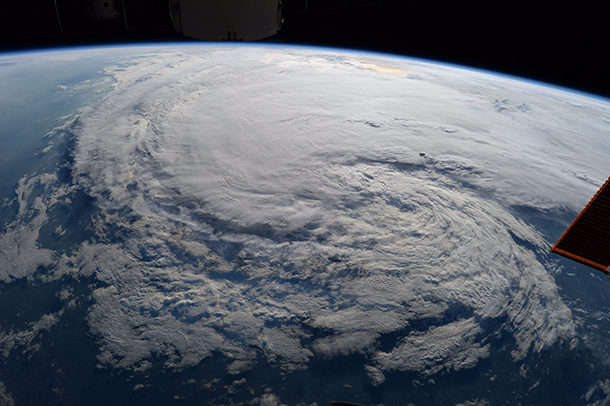
Astronaut Randy Bresnik captured this photo of Hurricane Harvey from the International Space Station on August 28th, 2017. (Photo: Randy Bresnik / NASA, Flickr CC BY 2.0)
CURWOOD: Kevin, President Trump's budget proposes cutting funding for satellites and other aspects including the entire NOAA - National Oceanic and Atmospheric Administration - budget. How could cuts to weather and climate data gathering satellites and systems impact the reliability of models and forecasts?
TRENBERTH: Yes, there's been some emphasis on improving weather forecasts in the Congress, but the climate cuts are potentially devastating because the way to really improve weather forecasts, especially when, on the extended rain, say going out beyond a week to a month or something like that, really involves what we would call climate process. It's the interactions between the atmosphere and the ocean and the, and the atmosphere in the land that we need to improve in our forecast models, and as part of the climate program and NOAA, all of the ocean observing system is paid for out of that. Knowing what is going on below the surface, which is the ocean heat content that supports the sea temperatures and which is up-welled to the surface and stirred up by hurricanes, knowing just what's going on there is absolutely vital information. So, it's quite short-sighted to cut the information that's really available. You know, it's one thing to have information. It's another thing as to what you do with that information, but let's at least get the information.
CURWOOD: Worldwide, how prepared do you think major cities are for the increased precipitation that can be seen in storms like Harvey for rain or, I guess, there are snow events as well?
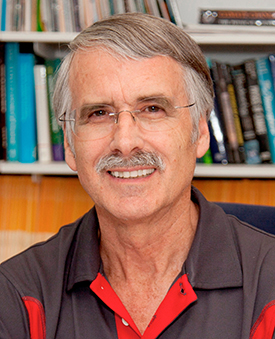
Kevin Trenberth is a distinguished senior scientist with the National Center for Atmospheric Research. (Photo: National Center for Atmospheric Research)
TRENBERTH: So, with climate change there are two things one would like to do. One is to slow down the process or stop it from happening in the first place. The second thing is to recognize that it's happening and adapt to it, and this means building resilience in particular, recognize that the threat from storms for flooding is much greater than it used to be. And so, we're seeing reports of thousand-year storms and certainly this is one. We had a couple last year with the Louisiana floods just over a year ago and also Hurricane Matthew in the Carolinas.
The statistics suggest that these were thousand-year storms. But these days they're really not. Because of climate change, they're more like 70 or 100 year storms. They're still relatively rare events and they're certainly extreme events, but their odds are actually increasing because of climate change.
Are cities preparing for this? Not adequately, nowhere. We're not doing enough to stop the problem and we're certainly not doing enough to prepare for it. All of these events these days have a component relating to climate change, which has a human component. It may be a relatively small fraction. It may be 10, 15 percent, something of that order. But, when you have an extreme event that's already going on, that extra 10 percent can push you across various thresholds, and once you cross these thresholds, things break. And we're seeing that more and more, in the US, where we've got very good infrastructure in general, but this is also true in other parts of the world.
CURWOOD: Kevin Trenberth is a distinguished Senior Scientist at the National Center for Atmospheric Research in Boulder, Colorado. Thanks so much for taking the time with us today.
TRENBERTH: Thanks it's been good to be with you.
Related links:
- AAAS Science Advances: Improved estimates of ocean heat content from 1960 to 2015—Kevin Trenberth, co-author
- Time: “A Timeline of Hurricane Harvey’s Development”
- A previous LOE interview with NCAR Senior scientist Kevin Trenberth
Justice After Storm Harvey

Twelve years have passed since Hurricane Katrina made landfall in 2005. The struggle to rebuild from that storm’s catastrophic damage suggests Houston’s road to recovery may also last more than a decade. (Photo: Tom, Wikimedia Commons CC BY-SA 3.0)
CURWOOD: Houston has been mostly sunny since Tropical Storm Harvey moved on, but the recovery has just barely begun, and it’s a monumental task. There’s no one better equipped to discuss how Texas communities will cope with the first category 4 storm to hit US shores, since Charley in 2004, than Robert Bullard. Robert Bullard is a Professor of Urban Planning and Environmental Policy at Texas Southern University in Houston, and a leading environmental justice scholar.
And, Bob, thanks for coming on the program. Welcome.

A member of the National Guard rescues a flood-stranded homeowner. (Photo: The National Guard, Flickr CC BY 2.0)
BULLARD: Thanks a lot for having me.
CURWOOD: So, how are you holding up in the wake of this massive storm?
BULLARD: Well, you know, I'm blessed. I'm fortunate. I did evacuate. We had a mandatory evacuation from Sugar Land, and actually I drove out. I didn't have to be carried out on boats, so I didn't have to walk out through the waters. But Harvey is no joke. This is some of the worst flooding and devastation that I've seen in my 40 years of working on issues around environment and justice in dealing with climate issues.
CURWOOD: So, which groups are experiencing the most hardship from the storm, and why, do you think?
BULLARD: Well, you , disasters and storms like this exacerbate inequality that existed pre-storm, before the storm. People say that the storm hits everybody the same, but everybody doesn't have the same resources to bounce back, and oftentimes governments exacerbate those disparities, when justice and fairness and equity are not somehow built into making communities bounce back and making them whole.
CURWOOD: Talk to me about the federal flood insurance program and how well or how poorly it does to protect those who are at social disadvantage.
BULLARD: Well, you know, the flood insurance program basically has run low. We have had disasters after disasters, and not enough money is put in that program, and many of our communities are located and built in areas that are very dangerous. And buying flood insurance and making sure that people have regular health insurance and other property insurance, those things are not equally distributed across our society, and so when disasters hit those individuals who may not have the resources to buy the kinds of protection that's needed, they'll basically be left behind.
So, the idea of insurance, it’s not enough just to have insurance. The fact that many of our communities, vulnerable communities, are placed at risk because of where they're located, because of redlining and because of residential segregation and land use policies that place certain populations in certain geographic locations. And in the south, you know, Jim Crow did it. Where you live oftentimes depended on not just your income but your race. Zip code is still the most potent factor that determines health and well-being, and all of zip codes are not created equal. So, having insurance is not necessarily provide protection, when it comes to equal protection.

The city of Houston covers more than 650 square miles. Its expansive sprawl poses serious challenges for rescue and recovery efforts, and exacerbates its racial and economic segregation. (Photo: Carol M. Highsmith, Wikimedia Commons CC BY-SA 3.0)
CURWOOD: Houston is a majority-minority city. The majority of people are some kind of color, largely Hispanic, but there’s a substantial black community, even an Asian community there. How is Houston doing, comparing to how New Orleans and the state of Louisiana dealt with Katrina?
BULLARD: Well, I think there are a number of similarities, in terms of the fact that New Orleans is a majority African-American city. Houston is a very diverse. It's one of the most racially diverse cities in the country. We're talking nearly three-quarters of the population are people of color. But, when you talk about diversity in terms of economics and political clout and decision-making, that diversity stops. And so, when we talk about making sure that when we get in the room and start talking about how we're going to rebuild our city and how we're going to revitalize and how we are going to plan for our future, that diversity somehow in many cases don't show up in the room, and that has to change, and I hope this tragedy will have a silver lining in that it will show that we have to do a better job in bringing, you know, that diversity into that decision-making process. And I think it's more than just "color-coordinating" a meeting. It has to be real, and it has to be authentic.

Robert Bullard is a distinguished professor of urban planning and environmental policy at Texas Southern University. (Photo: Bob Bullard)
CURWOOD: Professor, about a third of the nation's oil and gas reserves are housed in southeast Texas. What are the risks of an accidental release of toxic substances from that petro chemical complex? There were a lot of problems in New Orleans after Katrina along those lines.
BULLARD: I think we have to be very cognizant of the fact that we're in a very risky and precarious situation, in terms of where our refineries and petrochemical plants are located. And looking at the flooding and looking at the accounts, the many voices that have been speaking for decades in those fence-line communities as to what it means to live so close to the dangerous facilities. We have to start planning for reducing those risks and threats and talk about, how do we do something that's different and something that's better.
CURWOOD: Given the reality of climate change and climate disruption and the likelihood of more and more events like this, to what extent are local state and federal officials factoring climate disruption into plans to rebuild Houston?
BULLARD: Well, I think the local officials are strongly moving in that direction in building a climate action plan and a clean energy plan. As you move up the food chain, when you get to the state level, there's less inclination to talk about climate change as something that's real, and as when you get to the federal level, it's even less likely that people are advocating for and wanting to build that. But locally I think there's a strong emphasis to build climate resilient communities and build climate resiliency and climate action into that frame for rebuilding and recovery.
Now, how that will go over with the feds that are pushing money down this way and whether or not there will be some conflict or whether or not there will be you know, some pushback, we'll see. It's going to be a fight, and I do hope that there will be enough folks who are on the ground to say it's worth fighting for; otherwise, I think we're going to have some major conflict.
CURWOOD: Robert Bullard is a distinguished Professor of Urban Planning and Environmental Policy at Texas Southern University. Thanks so much for taking the time with us today. Bob.
BULLARD: Thanks for having me.
Related links:
- Prof. Robert Bullard, Texas Southern University
- Books written by Dr. Robert Bullard, including Race, Place and Environmental Justice After Katrina
- Our August, 2016 interview with Prof. Bullard, “Flint and Environmental Racism”
[MUSIC: Bill Monroe and the Bluegrass Boys, “I’m Working On a Building” on 20th Century Masters - The Millennium Collection: The Best of Bill Monroe, traditional southern American, MCA Gospel Records]
Beyond the Headlines
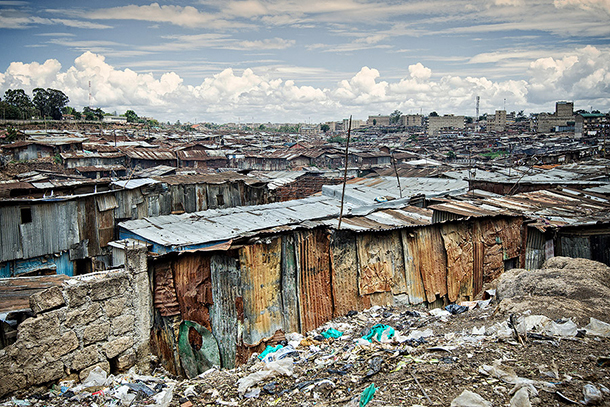
Kenya now has the world’s toughest ban on plastic bags, intended to combat pollution. Plastic pollution, as seen here in a slum outside Nairobi, is a major environmental issue for Kenya, but many residents oppose the ban since Kenya is a leading plastics manufacturer in the region. (Photo: Claudio Allia, Wikimedia Commons CC BY-SA 3.0)
CURWOOD: We’ve had a break over the summer, so it’s more than time to catch up with Peter Dykstra for the view beyond the headlines. Peter’s with Environmental Health News, EHN.org, and DailyClimate.org, and he’s on the line from Atlanta, Georgia.
Hi there, Peter.
DYKSTRA: Well hi, Steve. Hurricane Harvey is certainly the environmental story of the week if not the year, so let's just park our dark cloud over Houston for just a little bit more.
CURWOOD: Alright, more Harvey it is.
DYKSTRA: Well, first, the early estimates on flood insurance losses, $20 billion or more, likely a lot more than that. They’re on track with the huge losses first seen with Hurricane Andrew's toll back in 1992, when it hit Florida. That's a major reason why re-insurance companies, like Swiss-Re and Munich-Re – Those are the giant reinsurance companies that back up retail insurers in the wake of catastrophic losses -- They’re one of the first industries to have started sounding the climate alarm about climate risks, all the way back in the 20th century.
CURWOOD: Oh yeah, the 20th century. Where did the time go?
DYKSTRA: Indeed, and back here where we are in the 21st Century, what of the two Texans in the United States Senate, Ted Cruz and John Cornyn? Well, back in 2013, enough Republicans crossed party lines to guarantee smooth sailing for a federal aid package to help victims of Superstorm Sandy, primarily in the overwhelmingly Democratic states of New York and New Jersey. But the two Texan Senators were so upset by what they saw as pork-barrel larding of the aid package for two states controlled by Democrats that they voted against Sandy relief.
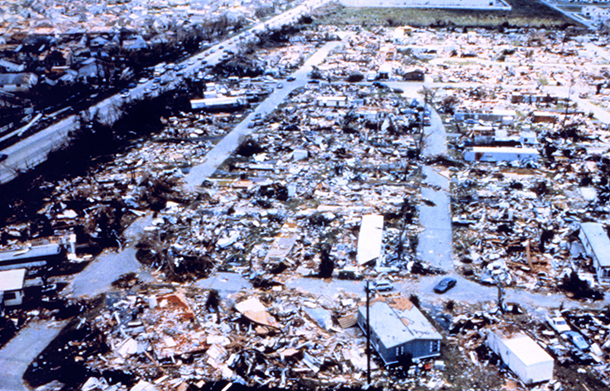
Hurricane Harvey is currently racking up damages comparable to Hurricane Andrew, which hit Florida in 1992, causing massive property damages. (Photo: NOAA Photo Library, Flickr CC BY 2.0)
CURWOOD: Hmmm, so let me guess. Now that a bright red state like Texas is up for federal help, those senators are leading the fight for Uncle Sam's money to help Harvey's victims, huh?
DYKSTRA: They are and all while charging their opponents with playing politics by attempting to link Harvey to politics by blaming climate change.
CURWOOD: Hmm. What's next?
DYKSTRA: According to Reuters, Kenya is enacting a plastic bag ban for the ages. Up to $40,000 in fines or four years in prison for using disposable plastic bags.
CURWOOD: Wow, anyone who's followed this issue knows that plastics in landfills or in our oceans or on the streets of developing countries has become a huge problem, but that kind of sounds rather draconian to me.
DYKSTRA: Yeah, it does, but Kenya's environment minister says the new law will target bag makers, and Kenya is one of the largest plastic bag-producing nations on Earth. They’re not gonna target a guy or a woman with a single plastic bag in the marketplace. And Kenya’s leading manufacturers lobby group says the ban will cost thousands of jobs and shut down businesses, so we’ll see how it all works out.
CURWOOD: We will indeed. Hey Peter, what have you brought us from the environmental history vault for this week?
DYKSTRA: Let's turn the clock back 29 years to the Presidential election of 1988. George H.W. Bush ultimately creamed Mike Dukakis, but, to help understand how that happened, we have to imagine a time when environment was front and center in a presidential campaign, and the Republican was attacking the Democrat for perceived inaction.
CURWOOD: Yes, this was back when Republican presidential candidates sometimes campaigned on the environment.
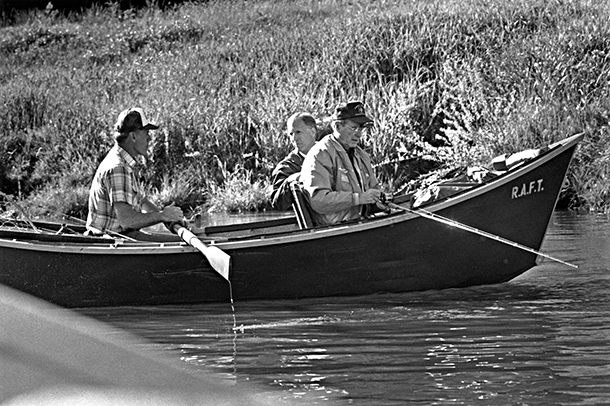
During the 1988 Presidential election, George H.W. Bush painted himself as a lover of outdoor recreation – he’s seen here fishing on the Rogue River in Oregon -- and vowed to be the “Environmental President.” (Photo: Bureau of Land Management, Flickr CC BY 2.0)
DYKSTRA: Yeah, that 20th century thing again. Two months before the election, Bush launched a brutal campaign focused on the Massachusetts Governor, Mike Dukakis, and his perceived failure to clean up Boston's "Harbor of Shame." And Bush vowed to be "The Environmental President."
CURWOOD: Well, the first President Bush did push through a strengthening of the Clean Air Act and signed the international climate agreement that led to the Kyoto Accord.
DYKSTRA: But four years later, he lost a re-election bid in which he labeled the Vice Presidential candidate Al Gore as "Ozone Man." So, go figure. But that pivot away from environmental concern was pretty much the last peep out of Republican White House environmentalism.
CURWOOD: But it did help give those of us in Boston our nice clean harbor.
Peter Dykstra is with Environmental Health News – that’s EHN.org and DailyClimate.org. Thanks Peter, talk to you again real soon.
DYKSTRA: OK, Steve, thanks a lot. Talk to you soon.
CURWOOD: And there’s more on these stories at our website, LOE.org.
Related links:
- ABC News: “As Harvey rages, Texas senators defend votes against Sandy funding”
- Reuters: “Kenya imposes world’s toughest law against plastic bags”
- The New York Times: “(GHW)Bush, in Enemy Waters, Says Rival Hindered Cleanup of Boston Harbor”
[MUSIC: The Standells “Dirty Water” on Dirty Water, Tower Records]
CURWOOD: Coming up...celebrating the wonders of walking. That’s just ahead here on Living on Earth. Stay tuned.
ANNOUNCER: Funding for Living on Earth comes from you our listeners, and United Technologies - combining passion for science with engineering to create solutions designed for sustainability in the aerospace, food refrigeration and building industries. UTC companies such as Otis, Carrier, Pratt & Whitney and UTC Aerospace Systems are helping to move the world forward. This is PRI, Public Radio International.
[CUTAWAY MUSIC: Miles Davis, “Nature Boy” on Miles Davis: Collector’s Items, composed by Eden Ahbez, Prestige Records/Concord Music Group]
Science Note: The Leaning Tree of New Caledonia
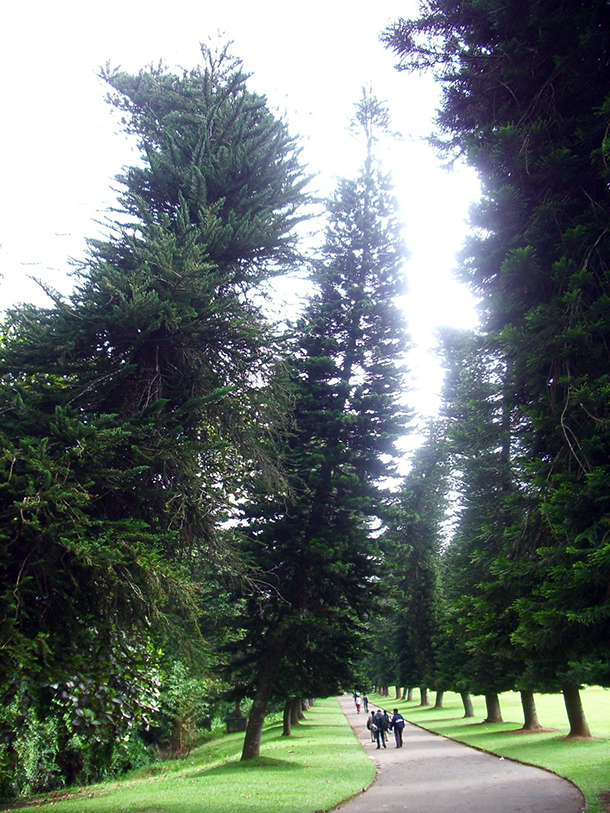
Cook Pine trees around the world tilt toward the Equator. (Photo: Kahuroa, Wikimedia Commons CC BY-SA 3.0)
CURWOOD: It’s Living on Earth, I’m Steve Curwood.
In a minute, some glories of mud. But first, this note on emerging science from Lizz Malloy.
[MUSIC: SCIENCE NOTE THEME]
MALLOY: All signs point south…or north depending on which side of the equator you, or rather your Cook Pine tree, resides.
Trees are often bent and gnarled by wind and weather over time, leaning this way and that, but the Cook pine leans with consistency. Once only found in New Caledonia, the Cook pine has traveled to many places around the world and is noted for the specific tilt in its trunk everywhere. But, until recently, nobody took much notice.
It turns out that the Cook Pine always leans towards the equator, a fact realized by a team at the California Polytechnic State University in San Luis Obispo, who were working on a book about urban trees in the Golden State.
Team leader, Matt Ritter, had thought that the tree only pointed south but after studying 256 Cook pines dispersed across the globe the researchers found that all of these trees point to the equator. They also noted that the further from the equator the trees are found the more extreme their tilt becomes. This growth pattern is not a completely unfamiliar trait in some smaller plants, but the Cook pine’s particular leaning habits are somewhat unprecedented among an entire species of tree.
While the reason behind the Cook pine’s equatorial slant remains unknown, researchers hope further study will help them solve this peculiar phenomenon.
That's this week’s note on emerging science. I’m Lizz Malloy.
Related links:
- Ecology Journal: Study on the lean of the Cook pine
- Science Alert: “Scientists Just Solved The Strange Case of Pine Trees That Always Lean Towards The Equator”
- Scientific American: “Roots Down, Shoots Up. But How Does a Plant Know Which is Which?
[MUSIC: SCIENCE NOTE THEME]
Walks of a Lifetime: Extraordinary Hikes From Around the World
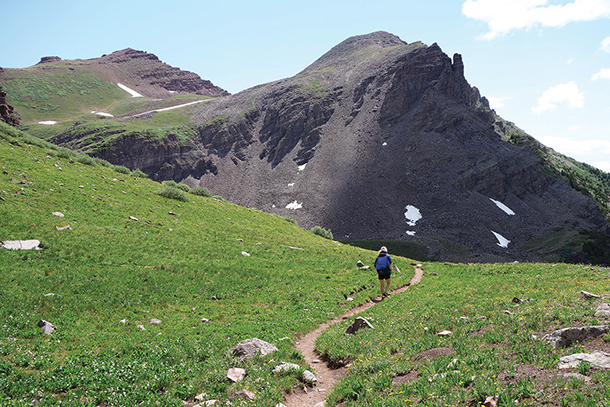
A hiker follows a path in the Maroon Bells-Snowmass Wilderness, along one of the walks featured in Walks of a Lifetime. (Photo: Bob & Martha Manning)
CURWOOD: Walking is the basic way humans get around, and though it’s not the fastest means of travel, it is a favorite. Even for the casual walker, it’s an unparalleled way to immerse oneself and truly experience a place – whether wilderness or urban.
A new book, "Walks of a Lifetime," aims to tantalize the armchair ambler and the would-be hiker with descriptions of thirty walks of varying length and difficulty, all over the world. Bob and Martha Manning are the authors, and they’ve logged thousands of miles on hikes of various lengths. And they’re on the line now.
So, Bob, let me start with you. How did you two get into long-distance walking?
BOB: Well, Steve, we've been pretty active most of our adult lives, visiting national parks and doing a lot of hiking, but about 15 years ago or so, we were living in Vermont, and Vermont has a long trail that's aptly named the Long Trail. It was the first long distance trail in the United States, and Martha and I decided to walk it. We did it in sections and ,after we finished, we just felt so good about it, and we enjoyed it so much that we began to look around for other long distance trails and found them, not only lots of them here in North America, but really all around the world, and we've been kind of obsessive about it lately.
And I guess about four or five years ago we decided that we really wanted to try and encourage other people to walk more in their everyday lives and consider doing some long distance walking, and so we started to write about some of our walks.
CURWOOD: Let me ask you, Martha, in your book you feature several essays on topics like the health of walking, the ethics of walking, and the “journey” versus the “destination” aspect of walking. Talk to me about those.
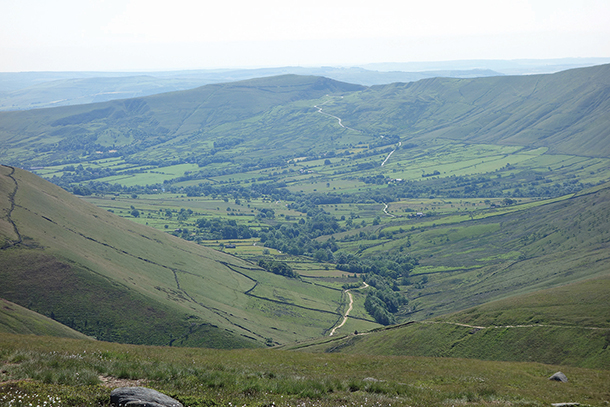
Between countries, walkers have different rights when it comes to rights of way. Above, a view of the Kinder Scout area in England, where in 1932 hundreds of walkers asserted their “right to roam;” unlike the U.S., walkers in the U.K. are generally allowed to cross private property. (Photo: Bob & Martha Manning)
MARTHA: Well, there's more to walking than just going out and putting one foot in front of the other. We thought it was important that people think about why they walk and the many dimensions that walking has and how enriching walking can be. And when you're talking about journey versus destination, for example, we used to be pretty goal oriented, that we wanted to get from point A to point B and then B to C and so forth, but we found that the more we walked, the more we were able to really relax into the experience itself, and that oftentimes, for example, on the religious pilgrimages, the walk itself became more important than the destination. And it's important for people to realize things like that that there are many benefits to walking. There are things they ought to be thinking about as they're partaking in this wonderful activity.
CURWOOD: At one point in your book you have this essay that you entitle "Sitting is the new form of smoking". What do you mean, Bob?
BOB: [LAUGHS] I think among the many benefits of walking, we're really recognizing now that health is certainly one of them. I think that we're experiencing an epidemic of obesity in the United States and elsewhere around the world. Many people have sedentary lifestyles, and walking is a way to really enrich your life in terms of physical and even mental health. There's imperical evidence to back this up from both a mental and physical health standpoint. So, walking for us can be a happy activity, one that we really enjoy, and it's got this added benefit of increasing our health as well.
CURWOOD: And what about the spiritual part? You said that there are these physical benefits. There's the mental health benefits. And what about connecting with the spiritual part of yourself?
BOB: Martha and I have walked several religious pilgrimages, routes that people have been walking, really, for 1,000 years or more, mostly for spiritual reasons. I think we weren't walking them for religious purposes, but I think actually we found that they maybe do have a spiritual dimension, even for non-religious people. They're an opportunity to really think about things that are important, to get away from the distractions of everyday life and to focus on things that are, you know, vital.
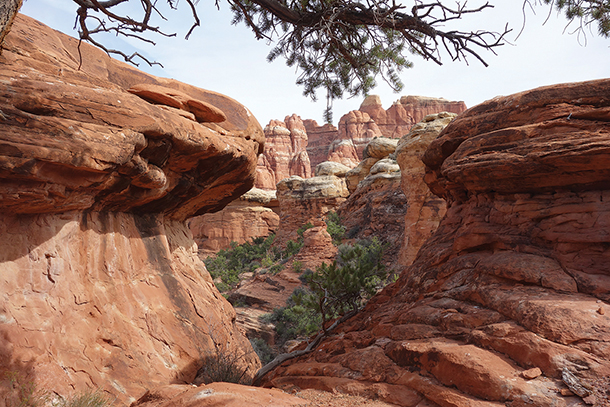
The Needles area in Utah is a rugged landscape, but trails help provide a safe as well as stunning journey through its red-rock canyons and stone arches. (Photo: Bob & Martha Manning)
MARTHA: When you're out there and the distractions of your home day-to-day life have been stripped away, all you're thinking about is getting from, getting along the trail, getting to the end point of the day, you take time to breathe deeply and relax into the experience to which you're passing, and then you look around at what you're passing through, and that's where the spiritual dimension came to me. I mean, sometimes it's a wonderful landscape that you're passing, but sometimes it's just knowing the passage of people through that landscape over such eons that affected me spiritually.
CURWOOD: Martha, which one of these religious pilgrimages did you find resonated the most with you spiritually and why?
MARTHA: I would say the El Camino de Santiago across northern Spain. It's 480 miles from the Pyrenees border with France to Santiago de Compostela in western Spain, and I expected it to be a very historical, a very interesting walk, and it certainly was, but you couldn't escape the spirituality. When you see places that are worn from the passage of pilgrims over a 1,000 years, you can't help but sense that other dimension that is there for so many people, and we chose to do the whole thing, but people do sections of it and come away with the same sensation.
CURWOOD: So, to what extent do different countries and regions have different conceptions of where walkers are allowed to roam?
BOB: You know, there is quite a difference and certainly in Europe. That's where we discovered a very different culture of walking. Walking is embedded more directly and more deeply into the cultures of many of the European countries and some other countries as well.
In the United States, I think certainly we have a history of doing a lot of hiking, but it's not so widely adopted as it is elsewhere. In Europe, for example, you're allowed in many cases to walk across private lands. Many of the trails perhaps even most of the trails are on private lands and that's well accepted phenomenon, very different than the United States, where we rely primarily on public lands.

The Great Wall of China is one of the “Walks of a Lifetime” the Mannings include in their new book. The “wilderness” section of the wall can present a significant physical challenge to walkers, as the way is rough and very steep in places. (Photo: Bob & Martha Manning)
CURWOOD: Martha, in the book there are number of walks that you outline in wilderness areas out away from everything, but you also talk about the value of urban walks. Talk to me about that now.
MARTHA: Well that's been a real surprise for me. We are not urban people, but we have begun to appreciate the joys of walking in urban environments, and we've walked both in Europe and Australia and in the United States and have found these urban walks to be really delightful. They’re a wonderful way to learn about a city and to really appreciate a city.
An example I might give you is the Great Saunter around the island of Manhattan in New York City. We lived in Vermont and were a little bit intimidated by the whole idea of New York City, but, walking around the very shoreline of the island of Manhattan, we learned to appreciate the different boroughs that we went through. We learned to appreciate the rivers - the Hudson, the Harlem, and the East rivers - and we learned to appreciate the diversity of people that populate New York City. It was just a thoroughly delightful experience.
We also have spent several days in Sydney and in Paris, walking out where the locals walk, and there's really no better way to learn a city. When we were in Paris, we never went in any of the museums. We walked all day, every day and came away feeling that we had appreciated that Paris is the museum itself, that we didn't need to go inside anywhere.
CURWOOD: Well, and, indeed, it goes back to the health angle, then, walking in Paris because you go by all those bakeries where you can just smell the fresh croissant and all the stuff that they serve up, but if you want to eat any of that, I guess you better walk it, huh?
MARTHA: Well, if you walk it, you can eat anything you want. [LAUGHS] That's the real benefit of walking.
CURWOOD: Martha what's it like to walk as a couple? You guys have been married how long?
MARTHA: We've been married for 49 years, and we find that walking is a real highlight of our lives together. We enjoy planning the walks. We enjoy doing the walks. We enjoy reliving the walks, and we have really gotten a lot of satisfaction out of writing these books and finding that we're encouraging other people to go out. It's really a gift to us, and I think they look at us, Steve, and they say, “Well, if they can do it, I can do it,” and they give it a try. But you certainly don't have to be a couple because there are all kinds of hiking organizations that provide walks in neighborhoods and communities, worldwide organizations. There are companies that match up people. Singles can come into groups. You need certainly don't have to be a couple to get a lot out of a walk.
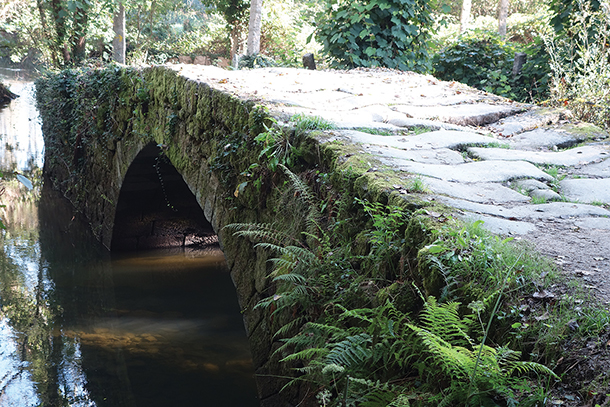
The stones of this ancient bridge on the Camino Portugués have been worn by centuries of pilgrims heading to Santiago de Compostela. (Photo: Bob & Martha Manning)
BOB: I found it amusing one day when Martha came home from having lunch with some of her women friends, and she said her women friends were asking her, “What do you two talk about all the time?” and I just thought that that was funny. You know, first of all, we don't talk the whole time we're hiking, but secondly it is an opportunity to talk about the things that are really important to us. You know, our family and our future and the values that we have and where we want to go on on our next hike. I mean, all these things are...maybe we don't have a lot of time to talk about them during the hecticness of our everyday lives, but the walks give us an opportunity to focus on these things that are more fundamental.
CURWOOD: Tell me, who do you see when you're out on the trail? Are they fairly well-to-do, white, educated couples such as the two of you, or, well, who do you see?
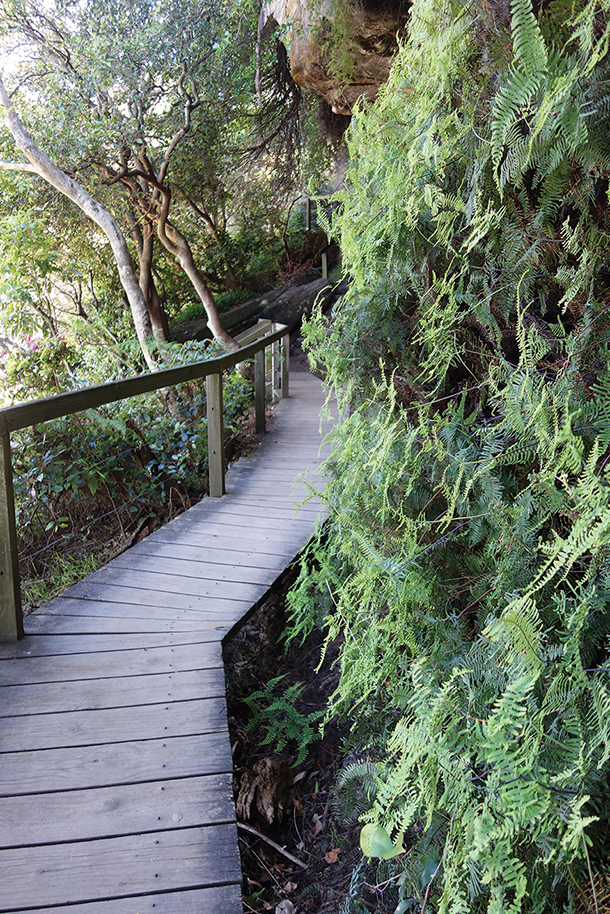
Walks of a Lifetime features trails suitable for experienced hikers as well as paths that look like the gentle Australian boardwalk above, for people who want or need a more leisurely walk. (Photo: Bob & Martha Manning)
BOB: It's a great diversity, and it has a lot to do with where we're walking. And that's one of the things that's made the urban walking a nice addition to our experiences, a nice addition to our portfolio of walks, if you will.
We have a daughter in Los Angeles and we go to visit her regularly, and we've done some walking in the Santa Monica Mountains National Recreation Area along a trail called the Backbone trail, a wonderful 60-some-mile trail that goes right into Los Angeles. There we see such a wide diversity of people, people of different ages, people of different races and ethnicities. That's been really very refreshing and why we've wanted to include urban walks in our newest book. I think it helps to sort of democratize long distance walking. It is possible to do that in urban regions, and hopefully, ultimately that might translate into walking into some more wild areas as well.
MARTHA: And I have to say in Europe you see people of all ages out walking, more so than you do in the United States. And one thing that has been a real joy for us to realize is that, universally, we found people to be lovely, and, if you're a walker, you're a walker. It doesn't matter what country you come from or what religion you have, or anything else. All that falls away and you talk about your experiences that you have in common rather than the experiences that separate us.
CURWOOD: So, for people who aren't particularly experienced in walking and hiking, what trail would you recommend that they possibly start with?
BOB: Well, I've got a couple of ideas about that, Steve. I think, first of all, I would suggest walking in your hometown, walking around in your neighborhoods. If you're fortunate enough to be able to walk back and forth to work, that's a great place to start, or to walk down to the grocery store instead of driving, or just go for an evening walk around the neighborhood. I think our books are about encouraging people to walk more in their everyday lives and then considering long distance walks. We've deliberately tried to offer a spectrum of opportunities.
I think that the carriage road system in Acadia National Park would be just the ideal place to start. It's the, really a very non-demanding but beautifully sited and managed 50-mile network of carriage roads, non-motorized roads, that one can walk around and really see Mount Desert Island, not only see it but really experience it, to hear it, to smell it, to go to Jordan Pond house for tea and taste it at the same time, and that's a good one to start with, but there are lots of other examples as well.
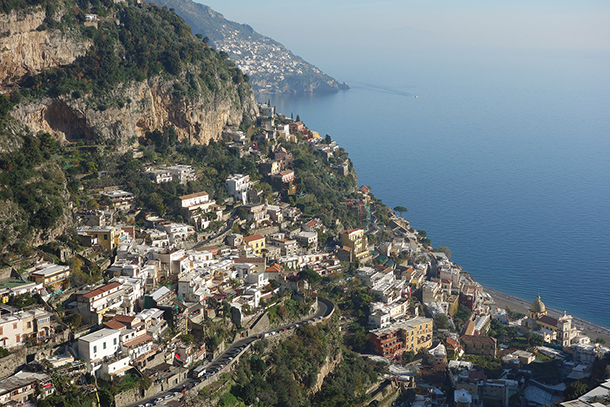
One central joy of walking is the intimate exposure to the local culture and everyday life. On the Amalfi Coast, the Mannings’ walks brought them into contact with the unique architecture, horticulture, and cuisine of this ancient place. (Photo: Bob & Martha Manning)
MARTHA: And we find that the more you hike in areas that are familiar and comfortable to you, the more confident you get in your abilities, the more you're going to enjoy when you're out in an unfamiliar environment where things are perhaps a little more challenging. You know that you can do the distance because you've been doing it locally.
CURWOOD: And by the way, how many miles have you walked now in your walking career?
BOB: Oh my goodness, I wish we'd started keeping track at the very beginning, but I took a look through the two books that we've written about long distance walking, and they total a little over 6,000 miles.
MARTHA: We figure, by the time we add in all the walking that we do to get ready and the walking we do just go visit the neighbors and that sort of thing, we’ve probably walked tens of thousands of miles. But I don't regret a single mile.
CURWOOD: OK, so how many pairs of walking shoes do you go through in a year?
BOB: Oh my goodness.
MARTHA: Numerous.
BOB: Yes, maybe a half a dozen pairs, anyway.
MARTHA: And if you look in our closets, we have our assortment of walking shoes, and then we have a few pairs of real shoes in there because normally we wear our walking shoes because you never know when you might get an opportunity to go for a little walk.
CURWOOD: Bob and Martha Manning are authors of the new book, "Walks of a Lifetime". Thanks so much for taking the time with me today.
BOB: You're welcome.
MARTHA: Happy trails.
Related link:
Walks of a Lifetime: Extraordinary Hikes from Around the World
BirdNote: Pungent Mudflat
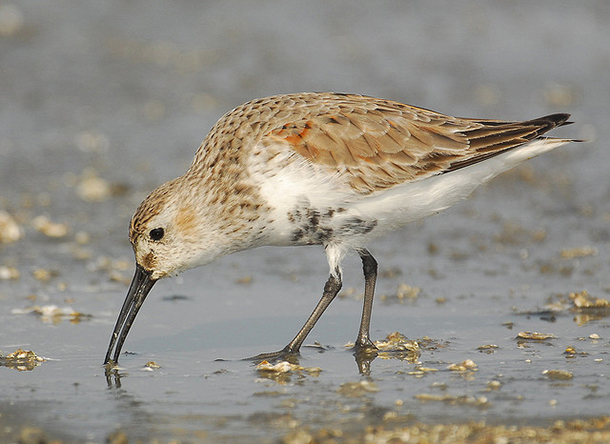
A Dunlin sandpiper forages in the mudflat. (Photo: Changua Conservation Action, Creative Commons)
[MUSIC: BIRDNOTE® THEME]
CURWOOD: As the water drains away on the Gulf coast, one reality residents will face is mud. But mud can have its uses, as Michael Stein explains in today’s BirdNote.
BirdNote®
The Pungent Mudflat
Written by Bob Sundstrom
[Glaucous-winged gulls crying, evoking the shoreline]
STEIN: Today we’re walking the shoreline of a saltwater bay. The tide’s going out, revealing a broad expanse of dark, glistening mudflat.
This muddy plain might appear a waste of natural space, a mere transient landscape awaiting the rising tide. And that low tide smell! On a hot day, it goes right by pungent, heading for malodorous!
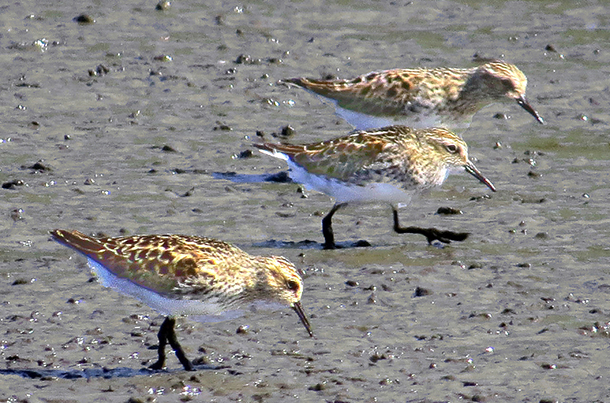
Least sandpipers in the mudflat. (Photo: Richard Griffin)
But that mudflat fragrance offers an important clue. Mudflats are rich in nutrients, such as decomposing organic matter and minerals. Mudflats, far from wastelands, support a bounty of life, such as foraging sandpipers called Dunlin.
[Large flock of Dunlin]
Much of this life lies below the surface. Scoop up a pail of mud and you might find – in addition to a clam or two big enough to eat – vast quantities of tiny snails and clams, worms, crustaceans, larvae, and much more.
Mudflats also support a bounty of bird life. Millions of shorebirds follow shorelines and their mudflats each spring and fall, where they feast upon those tiny creatures hidden beneath the mud’s surface, a banquet that powers the birds’ continent-spanning migrations.
So the next time you wrinkle your nose at low tide, imagine the countless creatures that draw their lifeblood from that fragrant mudflat.
[Glaucous-winged gulls crying, evoking the shoreline]
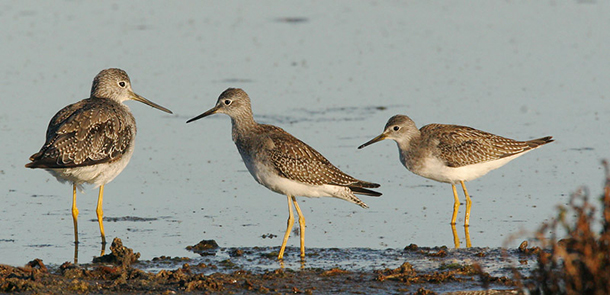
Greater and Lesser Yellowlegs. (Photo: Tom Grey)
I’m Michael Stein.
###
Sounds of birds provided by The Macaulay Library of Natural Sounds at the Cornell Lab of Ornithology, Ithaca, New York. Calls of Glaucous-winged Gull 137881 recorded by G. Vyn; calls of flock of Dunlin 59435-2 by W.W. H. Gunn
Mudflat ambient with gulls recorded by C. Peterson.
Producer: John Kessler
Executive Producer: Chris Peterson
© 2012-2017 Tune In to Nature.org, September 2017 Narrator: Michael Stein
http://birdnote.org/show/pungent-mudflat
CURWOOD: For photos, ooze on over to our website, LOE.org.
Related link:
“The Pungent Mudflat” on the BirdNote® website
[MUSIC: Jacques Loussier Trio, “Water Music Allegro I,” composed by Georg Friedrich Handel, Telarc Records]
CURWOOD: Living on Earth is produced by the World Media Foundation. Our crew includes Naomi Arenberg, Bobby Bascomb, Savannah Christiansen, Jenni Doering, Noble Ingram, Jaime Kaiser, Don Lyman, Helen Palmer, Olivia Reardon, Adelaide Chen, and Jolanda Omari.
And we bid a grateful farewell this week to our great crew of summer interns, Matt Hoisch, Lizz Malloy, and Rebecca Redelmeier.
Tom Tiger engineered our show, with help from John Jessoe and Jake Rego.
Alison Lirish Dean composed our themes. You can find us anytime at LOE.org -- and like us, please, on our Facebook page -- PRI’s Living on Earth. And we tweet from @LivingonEarth. I'm Steve Curwood. Thanks for listening.
ANNOUNCER1: Funding for Living on Earth comes you, our listeners, and from the University of Massachusetts, Boston, in association with its School for the Environment, developing the next generation of environmental leaders. And from the Grantham Foundation for the protection of the environment, supporting strategic communications and collaboration in solving the world’s most pressing environmental problems. Support also comes from the Energy Foundation, serving the public interest by helping to build a strong, clean, energy economy, from Gilman Ordway, and from SolarCity, America’s solar power provider. SolarCity is dedicated to revolutionizing the way energy is delivered by giving customers a renewable alternative to fossil fuels. Information at 888-997-1703. That’s 888-997-1703.
ANNOUNCER2: PRI. Public Radio International.
Living on Earth wants to hear from you!
Living on Earth
62 Calef Highway, Suite 212
Lee, NH 03861
Telephone: 617-287-4121
E-mail: comments@loe.org
Newsletter [Click here]
Donate to Living on Earth!
Living on Earth is an independent media program and relies entirely on contributions from listeners and institutions supporting public service. Please donate now to preserve an independent environmental voice.
NewsletterLiving on Earth offers a weekly delivery of the show's rundown to your mailbox. Sign up for our newsletter today!
 Sailors For The Sea: Be the change you want to sea.
Sailors For The Sea: Be the change you want to sea.
 The Grantham Foundation for the Protection of the Environment: Committed to protecting and improving the health of the global environment.
The Grantham Foundation for the Protection of the Environment: Committed to protecting and improving the health of the global environment.
 Contribute to Living on Earth and receive, as our gift to you, an archival print of one of Mark Seth Lender's extraordinary wildlife photographs. Follow the link to see Mark's current collection of photographs.
Contribute to Living on Earth and receive, as our gift to you, an archival print of one of Mark Seth Lender's extraordinary wildlife photographs. Follow the link to see Mark's current collection of photographs.
 Buy a signed copy of Mark Seth Lender's book Smeagull the Seagull & support Living on Earth
Buy a signed copy of Mark Seth Lender's book Smeagull the Seagull & support Living on Earth

